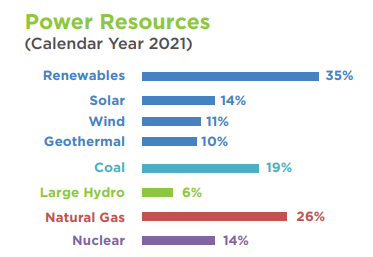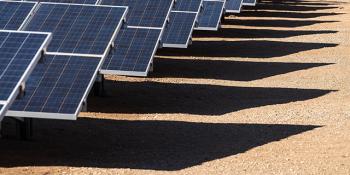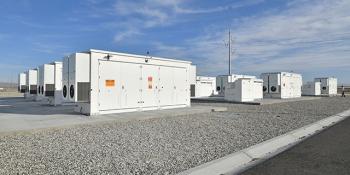LADWP is the nation’s largest municipal power utility with a net maximum plant capacity of 10,730 megawatts (MW) and net dependable capacity of 8,007 MW. In fiscal year 2022-23, we supplied more than 21,600 gigawatt-hours (GWh) of power for more than 1.6 million electric service customers, including 5,702 in the Owens Valley. We maintain a diverse and vertically integrated power generation, transmission and distribution system that spans five Western states, and we deliver reliable, cost-efficient power to more than 4 million people in Los Angeles.
Sources of Power


Power Reliability and Resiliency
Distribution Upgrades
In FY 2022-23, our power crews completed repairs on more than 8,046 infrastructure-related jobs. We met or exceeded our distribution equipment replacement targets for transformers and substructures as well as system growth targets for overhead and underground reconductoring and 34.5kV trunk line circuits. We are also on track to meet our FY 2023-24 targets.
Our long-term goals call for expanding capacity to address our undersized 4.8 kV distribution system. Currently, more than 300 electrical lines carry power loads that are above their rated capacity. By 2035, we plan to build additional distributing station and receiving station capacity to meet forecasted capacity needs of approximately 350-450 MVA and 90 MVA, respectively.
Wildfire Mitigation Plan
Wildfires have posed a significant threat to public safety. We have a Wildfire Mitigation Plan to keep our customers safe, and our power service reliable and resilient. Updated annually as mandated by the state, the plan describes how we continually mitigate the threat of wildfires posed by electrical lines and equipment. Our plan includes preventative strategies and programs such as system hardening through design and construction, vegetation management, operating protocols, and inspection and maintenance programs. In 2023, we completed a comprehensive update to our Wildfire Mitigation Plan, which was reviewed by an independent evaluator who determined it to be comprehensive and in compliance with all statutory requirements.
Transmission Upgrades
As we transition to a clean energy future, we are planning, designing and building numerous transmission lines and related infrastructure. New and expanded capacity on transmission systems is necessary to ensure reliability and resiliency as we produce and deliver more renewable energy to our customers.
A Clean Energy Future for Los Angeles
LADWP is creating a clean energy future for Los Angeles while maintaining a reliable and cost-effective power supply for customers, and doing so in a way that leads with equity. The groundbreaking Los Angeles 100 Percent Renewable Energy Study (LA100) provided the roadmap for delivering reliable and sustainable electricity to our customers. The follow-up study—LA 100 Equity Strategies—showed how LADWP can achieve our clean energy goals in a way that benefits all Angelenos and leaves no community behind. With the completion of LA100 Equity Strategies in the fall of 2023, LADWP announced a collection of equity-driven programs and policies under the umbrella program, Powered by Equity.
LA100 Equity Strategies
LA100 Equity Strategies wrapped up in 2023, offering in-depth analysis of energy-related inequities that have impacted underserved communities of Los Angeles. Under the leadership of the Board of Water and Power Commissioners, we worked with the U.S. Department of Energy’s National Renewable Energy Laboratory (NREL), which also authored LA100, and UCLA to conduct LA100 Equity Strategies. The goal was to determine intentionally-designed programs and policies that would ensure that LA’s underserved communities are not left behind or further burdened as we make significant investments to transition to a clean energy future.
Powered by Equity
On the heels of the public release of LA100 Equity Strategies, we announced an array of new or expanded programs under “Powered by Equity.” Among these programs meant to improve energy equity in underserved areas, is a comprehensive plan to build, operate and maintain a city-owned network of electric vehicle ‘fast-charger’ hubs in the city’s disadvantaged communities. These publicly available charging hubs will be strategically located in areas where EV charging capacity lags behind more affluent communities.
Expanding Renewable Energy
Growing Local Solar
We continue to ramp up our distributed energy resources (DER) programs—small-scale energy resources connected to the local distribution system. DERs include local solar projects on rooftops in Los Angeles as well as battery storage and microgrids. Our goals are to expand local solar by deploying 1,000 MW and offsetting approximately 600 MW of power capacity during peak periods through demand response programs by 2035. To date, we have achieved 50 percent or greater participation from disadvantaged communities in the majority of our DER programs.
Adopting Energy Storage
Our plan is to build over 1,000 MW of energy storage in-basin and out-of-basin by 2030, as called for by the LA100 study. We are evaluating proposals for new energy storage projects at the Beacon Energy Storage Center, situated near several of our renewable facilities in the Mojave Desert. Additionally, we have completed the demolition of Haynes Units 3 through 6 to make room for future energy storage systems. In partnership with the Electric Power Research Institute (EPRI) and other utilities, LADWP is applying for both Federal and State funding to develop new energy storage projects. This funding will decrease overall project costs to minimize the impact to customer rates.
Developing Flexible Demand
As load growth expands, LADWP must ensure these loads do not impact grid stability and reliability. In order to achieve this, we will need to shift customer energy usage away from the peak periods. By offering demand response (DR) programs with attractive incentives encourages customers to adopt strategies to shift their energy usage away from the peak demand periods.
Electrifying Transportation
LADWP plays a vital role in converting our city’s car culture into clean, zero-emission vehicles and transit. As the city’s electric service provider, we offer incentives to encourage customers to drive electric while expanding the necessary charging infrastructure to make EVs a reliable, convenient, and affordable mode of transportation for Angelenos and visitors.
We are on track to meet our next electric transportation milestones of 45,000 commercial EV chargers and 250,000 EVs in the City of Los Angeles by 2025, providing zero-emission transportation infrastructure for the 2028 Summer Olympic and Paralympic Games, on the road to the goals of 120,000 chargers to support 750,000 EVs in the city by 2030.
Clean Energy Monitor
View real-time data related to LADWP's clean energy generation.
Investing in Energy Efficiency
Energy efficiency continues to be a key strategy for transitioning our power supply to 100 percent clean energy, providing a cost-effective way to reduce GHG emissions. Energy efficiency supports system reliability and resiliency while enabling customers to save on their electric bill. Additionally, under-resourced communities can benefit from electrification and energy efficiency. A core component and important goal of equitable electrification is to deliver economic benefits to empower our local communities and uplift all segments of society.
Energy Efficiency Goals
We met and exceeded our target of 15 percent cumulative energy savings from 2010 through 2020, representing 3,408 gigawatt-hours (GWh) of independently verified savings; enough to offset the electricity needs of 564,500 homes, and avoid over 1 million metric tons of GHG emissions. In the 2022 SLTRP, LADWP is projected to maintain the same pace of reducing energy use in Los Angeles by an additional cumulative savings of 3,140 GWh by 2035, surpassing the efficiency levels projected by the LA100 study.
Building Electrification
Converting homes and other buildings to electricity is critical for meeting California’s ambitious decarbonization goals. LADWP continues to play an active role with partner agencies and organizations to drive building electrification. To support our city’s clean energy goals and provide savings for our customers, LADWP is committed to promoting zero-carbon energy new construction projects and making high-efficiency electric heating, ventilation and air conditioning (HVAC) technology more accessible and affordable to all Angelenos.
Power Programs
-

Demand Response Program
LADWP’s Demand Response (DR) is an incentive based, voluntary energy management program for businesses that helps reduce their utility bills during times of peak power demand, ensuring the continued reliability of power for Los Angeles.
-
Demand Side Grid Support (DSGS) Program
The Demand Side Grid Support (DSGS) Program will offer incentives to electric customers that provide load reduction and backup generation to support the state’s electrical grid during extreme events, reducing the risk of blackouts.
-

Efficient Product Marketplace (EPM)
The EPM is a convenient online marketplace that allows you to shop a selection of popular energy-efficient brands available at numerous stores and online retailers with pricing and available rebate information.
-

Energy Advisor
The Energy Advisor Tool helps you assess your home energy use. Answer a few questions and you will receive a comprehensive report on how to reduce energy consumption and save on your bill. The tool provides a home energy use calculator, bill analysis, energy forecasting, and savings tips.
-

Feed-in Tariff (FiT) Program
The FiT program allows property owners and developers to sell the output of local eligible renewable energy projects directly to LADWP (as opposed to consuming the energy onsite to satisfy the customer’s load).
-

Feed-in Tariff Plus (FiT+) Pilot Program
The FiT+ Pilot Program expands upon the existing FiT program to further promote the use of locally generated solar energy and to ensure the deployment of energy storage projects that can dispatch solar energy in a manner that optimizes the deliverability of renewable energy to nearby load centers at hours that are most beneficial for the electric grid.
-

Food Service Program
LADWP offers incentives for new energy efficient cooking and cooking process equipment. Under this program your business may qualify for a financial incentive when you purchase equipment such as ovens, griddles, steam cookers, holding cabinets, glass and solid door refrigerators/freezers, and icemakers for your business.
-

Green Power for a Green L.A.™ Program
The Green Power for a Green L.A. program gives Los Angeles residents, businesses, and governmental agencies a stake in helping to preserve and protect our environment through their voluntary contribution to support additional renewable energy.
